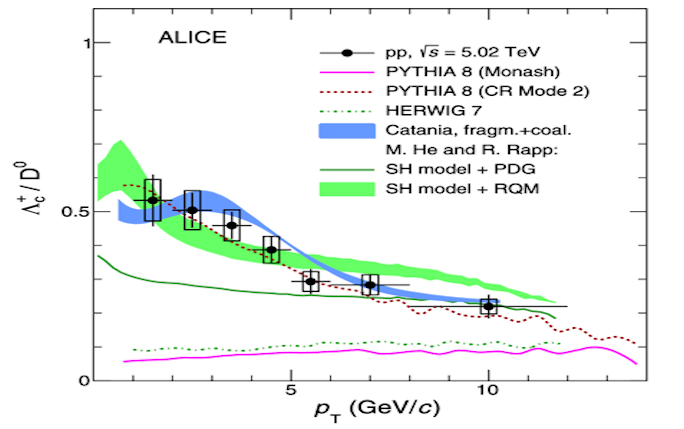Charm likes to 'baryonise' at the LHC

The Large Hadron Collider at CERN collides protons and heavy nuclei at extremely high energies, and, along with searches for new physics, it provides an excellent laboratory to test our current theories of how the building blocks of nature work. The ALICE experiment, one of the four LHC experiments, is dedicated to studying the strong interaction – one of the four fundamental forces of nature, responsible for binding quarks into hadrons, such as protons and neutrons.
The measurement of the production rates of hadrons which contain charm quarks at the Large Hadron Collider is a sensitive test how charm quarks are formed, and how they subsequently combine with other quarks to form a hadron - a ‘composite’ particle formed from either two or three quarks - under the strong interaction. By measuring the relative production of charmed baryons (a hadron containing three quarks) and mesons (a hadron containing instead two quarks), we can learn about the low-energy dynamics that allow charm quarks to form hadrons, a process which is very difficult to calculate and thus often relies on experimental input. It is often assumed that the processes turning charm quarks to charmed hadrons are independent of the environment in which they are formed, which would cause the ratios of the production rates of charmed hadrons in electron-electron, electron-proton and proton-proton interactions to be the same. However, recent measurements of the charmed baryon Λc+ challenge this assumption. This work is a joint publication in ‘Physical Review Letters’ and ‘Physical Review C’, and was led by our ALICE group, in particular Dr Jaime Norman and PhD student Chris Hills. It provides important information on how baryons and mesons are formed in high-energy hadron collisions.

In this work the production rate of the charmed baryon Λc + and the baryon-to-meson ratio Λc+/D0 (the ratio of the production rate of Λc + baryons, to that of D0 mesons), have been measured in proton-proton and proton-lead collisions. The Λc+/D0 ratios are up to 5 times larger than measurements of the same ratios in electron-electron and electron-proton collisions, indicating that charmed baryons are produced more frequently in hadronic collisions. Theoretical calculations which include effects that modify the process of charmed baryon formation due to the high-density environment of proton-proton collisions at the LHC can reproduce the measurement, giving potential explanations for this enhancement. The Λc+/D0 ratios are also compared to similar measurements of hadrons with different quark content - the similarity between the light flavour (hadrons with quark content no heavier than strange quarks) and charm baryon-to-meson ratios also provides indications, for the first time, that mechanisms governing the production of light-flavour and charmed baryons may be similar. These measurements also provide a crucial reference for future measurements in lead-lead collisions at the Large Hadron Collider, where the hottest temperatures ever created in a laboratory allow for a new state of matter of deconfined quarks and gluons, the Quark-Gluon Plasma, to be formed.
Further reading
ALICE Collaboration, 2021
Phys. Rev. C 104, 054905, https://doi.org/10.1103/PhysRevC.104.054905
Phys. Rev. Lett. 127, 202301, https://doi.org/10.1103/PhysRevLett.127.202301